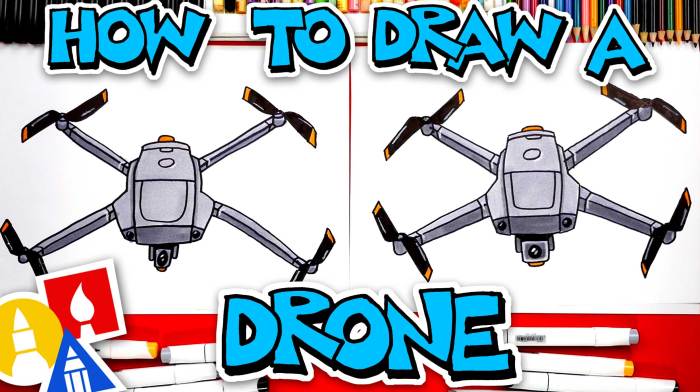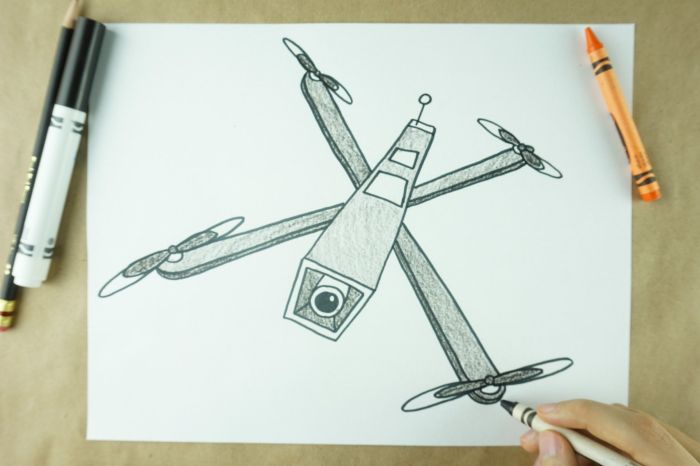Mit drone capable of following your drawing – MIT Drone Follows Your Drawings, a groundbreaking technology that allows drones to navigate based on user-drawn paths. Imagine sketching a route on a piece of paper and watching a drone flawlessly execute your design, soaring through the air with precision and grace. This innovative technology, born from MIT’s advanced research in robotics and computer vision, pushes the boundaries of drone capabilities and opens up a world of possibilities for various industries.
The core of this technology lies in the drone’s ability to interpret and translate your drawings into actionable flight paths. Using sophisticated image processing techniques, the drone analyzes your drawing, extracting key features and geometric information to construct a 3D flight path. This process involves overcoming challenges such as scale, perspective, and ambiguity, ensuring the drone accurately translates your intentions into flight maneuvers.
Drawing Interpretation and Translation

The drone’s ability to follow a user’s drawing relies on a sophisticated system that interprets the drawing, translates it into a flight path, and guides the drone accordingly. This process involves a series of steps, from image processing to geometric analysis, ensuring the drone accurately replicates the user’s intent.
Image Processing and Feature Extraction
The first step involves capturing the user’s drawing, typically through a camera or a digital input device. The captured image is then processed to extract relevant features, such as lines, curves, and points. This process employs image processing techniques like edge detection, line segmentation, and corner detection.
Geometric Analysis and Path Generation
Once the drawing features are extracted, the system analyzes their geometric relationships to understand the intended flight path. This involves calculating distances, angles, and curvatures. The system then converts the 2D drawing into a 3D flight path by considering factors like scale, perspective, and potential ambiguities.
Waypoint Generation and Navigation
The 3D flight path is then translated into a series of waypoints, which are specific points in space that the drone must navigate. These waypoints are sent to the drone’s navigation system, which guides the drone along the desired path. The drone’s onboard sensors and control systems ensure accurate navigation and obstacle avoidance, allowing it to follow the user’s drawing with precision.
Drone Navigation and Control

The drone’s navigation system is the core of its ability to follow the drawn path. This system uses a combination of advanced control algorithms, sensors, and communication protocols to ensure precise and safe flight.
Control Systems and Algorithms
The drone’s navigation system relies on sophisticated control algorithms to translate the interpreted drawing into a series of flight commands. These algorithms take into account factors like wind, obstacles, and terrain to ensure smooth and accurate flight.
- PID (Proportional-Integral-Derivative) Control: This widely used control technique is employed to adjust the drone’s position and orientation based on real-time feedback from sensors. It helps maintain stability and responsiveness during flight.
- Path Planning Algorithms: These algorithms determine the optimal flight path based on the interpreted drawing, taking into account obstacles and terrain. Common algorithms include A* search and Dijkstra’s algorithm.
- Trajectory Tracking Algorithms: These algorithms ensure the drone follows the planned path accurately. They use feedback from sensors to adjust the drone’s trajectory in real-time, compensating for factors like wind gusts and unexpected obstacles.
Sensors and Real-Time Feedback
Sensors play a crucial role in providing real-time feedback to the navigation system, enabling it to adjust the drone’s trajectory and ensure safe flight.
- GPS (Global Positioning System): GPS provides the drone’s location and altitude, crucial for accurate navigation and path following.
- Cameras: Cameras are used for visual navigation, obstacle avoidance, and image recognition. They provide the drone with a visual understanding of its surroundings, allowing it to identify obstacles and adjust its flight path accordingly.
- Lidar (Light Detection and Ranging): Lidar sensors emit laser beams to measure distances to objects, providing a 3D map of the environment. This data is used for precise obstacle avoidance and terrain mapping.
- IMU (Inertial Measurement Unit): IMUs measure the drone’s acceleration and angular velocity, providing data for attitude and heading control.
Autonomous Navigation and Drawing Interpretation, Mit drone capable of following your drawing
The drone’s autonomous navigation system seamlessly integrates with the drawing interpretation system, ensuring accurate and safe flight. The drawing interpretation system provides the navigation system with the desired path, and the navigation system uses the sensor data to ensure the drone follows the path precisely.
The navigation system continuously updates the drone’s trajectory based on real-time feedback from sensors, allowing it to adapt to changing conditions and avoid obstacles.
Applications and Potential: Mit Drone Capable Of Following Your Drawing
The ability of a drone to follow a drawing opens up a wide range of possibilities for practical applications in various industries. This technology can be used to automate tasks, improve efficiency, and enhance safety in a multitude of scenarios.
Search and Rescue
A drone capable of following drawings can significantly enhance search and rescue operations by providing a more efficient and precise way to navigate complex terrains. For instance, in a disaster zone, the drone could be programmed to follow a pre-drawn map of the affected area, enabling it to search for survivors in areas inaccessible to humans. It could also be used to deliver essential supplies to those in need.
Inspection
Drones equipped with this technology can be used to inspect infrastructure, such as bridges, pipelines, and power lines, by following pre-drawn plans of the structures. This allows for more thorough and efficient inspections, potentially identifying potential problems before they become major issues. The ability to follow drawings also allows for the inspection of hard-to-reach areas, such as the underside of bridges or the inside of pipes.
Surveillance
This technology can be used for surveillance purposes, allowing for the monitoring of large areas or specific locations. For example, a drone could be programmed to follow a drawing of a perimeter, providing real-time surveillance of a property or a sensitive area. The drone’s ability to follow drawings can also be used to track movement patterns or identify suspicious activities.
Entertainment
The ability of a drone to follow drawings can be used for entertainment purposes, creating unique and engaging experiences. For example, a drone could be programmed to follow a drawing of a specific route, creating a light show or a dance performance in the sky. This technology can also be used for interactive entertainment, where users can draw their own paths for the drone to follow.
Benefits and Challenges
The use of drones capable of following drawings has the potential to bring significant benefits to various industries. For example, in the construction industry, these drones could be used to inspect buildings, monitor progress, and deliver materials, potentially improving efficiency and reducing costs. In agriculture, drones could be used to monitor crops, spray pesticides, and deliver fertilizer, improving yields and reducing environmental impact. In logistics, drones could be used for package delivery, potentially reducing delivery times and costs.
However, there are also challenges associated with this technology. For example, the accuracy of the drone’s navigation system is crucial for its effectiveness, and any errors in the drawing could lead to inaccurate navigation. There are also concerns about privacy and security, as drones could be used for unauthorized surveillance or data collection.
MIT’s drone capable of following your drawings represents a significant leap forward in drone technology, promising a future where human creativity and drone automation converge. From search and rescue missions to intricate aerial inspections, this technology has the potential to revolutionize various industries, empowering us to interact with drones in ways previously unimaginable. As research continues, we can anticipate even more advanced capabilities, pushing the boundaries of what drones can achieve and opening up a world of exciting possibilities.
Imagine a drone that can follow your drawings in real-time, a technological marvel that could revolutionize filmmaking or even help with search and rescue operations. While this sounds like something out of a comic book, the world of technology is constantly evolving, and who knows what the future holds? Perhaps this drone will be as popular as the release of Batman v Superman: Dawn of Justice , which shattered box office records upon its release.
This groundbreaking drone could be just around the corner, bringing the power of imagination to life in a whole new way.